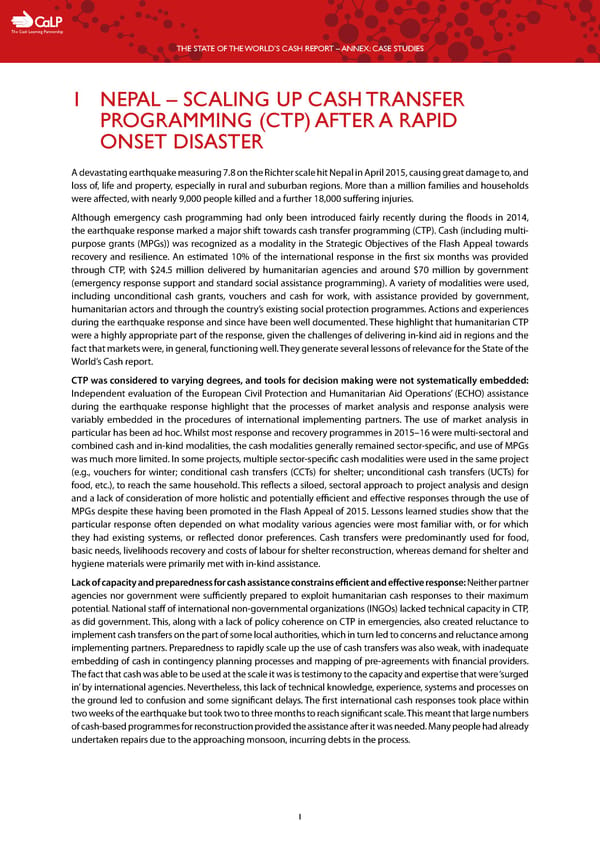C The Cash Learning Partnership THE STATE OF THE WORLD’S CASH REPORT – ANNEX: CASE STUDIES 1 NEPAL – SCALING UP CASH TRANSFER PROGRAMMING (CTP) AFTER A RAPID ONSET DISASTER A devastating earthquake measuring 7.8 on the Richter scale hit Nepal in April 2015, causing great damage to, and loss of, life and property, especially in rural and suburban regions. More than a million families and households were affected, with nearly 9,000 people killed and a further 18,000 suffering injuries. Although emergency cash programming had only been introduced fairly recently during the floods in 2014, the earthquake response marked a major shift towards cash transfer programming (CTP). Cash (including multi- purpose grants (MPGs)) was recognized as a modality in the Strategic Objectives of the Flash Appeal towards recovery and resilience. An estimated 10% of the international response in the first six months was provided through CTP, with $24.5 million delivered by humanitarian agencies and around $70 million by government (emergency response support and standard social assistance programming). A variety of modalities were used, including unconditional cash grants, vouchers and cash for work, with assistance provided by government, humanitarian actors and through the country’s existing social protection programmes. Actions and experiences during the earthquake response and since have been well documented. These highlight that humanitarian CTP were a highly appropriate part of the response, given the challenges of delivering in-kind aid in regions and the fact that markets were, in general, functioning well. They generate several lessons of relevance for the State of the World’s Cash report. CTP was considered to varying degrees, and tools for decision making were not systematically embedded: Independent evaluation of the European Civil Protection and Humanitarian Aid Operations’ (ECHO) assistance during the earthquake response highlight that the processes of market analysis and response analysis were variably embedded in the procedures of international implementing partners. The use of market analysis in particular has been ad hoc. Whilst most response and recovery programmes in 2015–16 were multi-sectoral and combined cash and in-kind modalities, the cash modalities generally remained sector-specific, and use of MPGs was much more limited. In some projects, multiple sector-specific cash modalities were used in the same project (e.g., vouchers for winter; conditional cash transfers (CCTs) for shelter; unconditional cash transfers (UCTs) for food, etc.), to reach the same household. This reflects a siloed, sectoral approach to project analysis and design and a lack of consideration of more holistic and potentially efficient and effective responses through the use of MPGs despite these having been promoted in the Flash Appeal of 2015. Lessons learned studies show that the particular response often depended on what modality various agencies were most familiar with, or for which they had existing systems, or reflected donor preferences. Cash transfers were predominantly used for food, basic needs, livelihoods recovery and costs of labour for shelter reconstruction, whereas demand for shelter and hygiene materials were primarily met with in-kind assistance. Lack of capacity and preparedness for cash assistance constrains efficient and effective response: Neither partner agencies nor government were sufficiently prepared to exploit humanitarian cash responses to their maximum potential. National staff of international non-governmental organizations (INGOs) lacked technical capacity in CTP, as did government. This, along with a lack of policy coherence on CTP in emergencies, also created reluctance to implement cash transfers on the part of some local authorities, which in turn led to concerns and reluctance among implementing partners. Preparedness to rapidly scale up the use of cash transfers was also weak, with inadequate embedding of cash in contingency planning processes and mapping of pre-agreements with financial providers. The fact that cash was able to be used at the scale it was is testimony to the capacity and expertise that were ‘surged in’ by international agencies. Nevertheless, this lack of technical knowledge, experience, systems and processes on the ground led to confusion and some significant delays. The first international cash responses took place within two weeks of the earthquake but took two to three months to reach significant scale. This meant that large numbers of cash-based programmes for reconstruction provided the assistance after it was needed. Many people had already undertaken repairs due to the approaching monsoon, incurring debts in the process. 1
 The State of the World's Cash | Case Studies Page 2 Page 4
The State of the World's Cash | Case Studies Page 2 Page 4